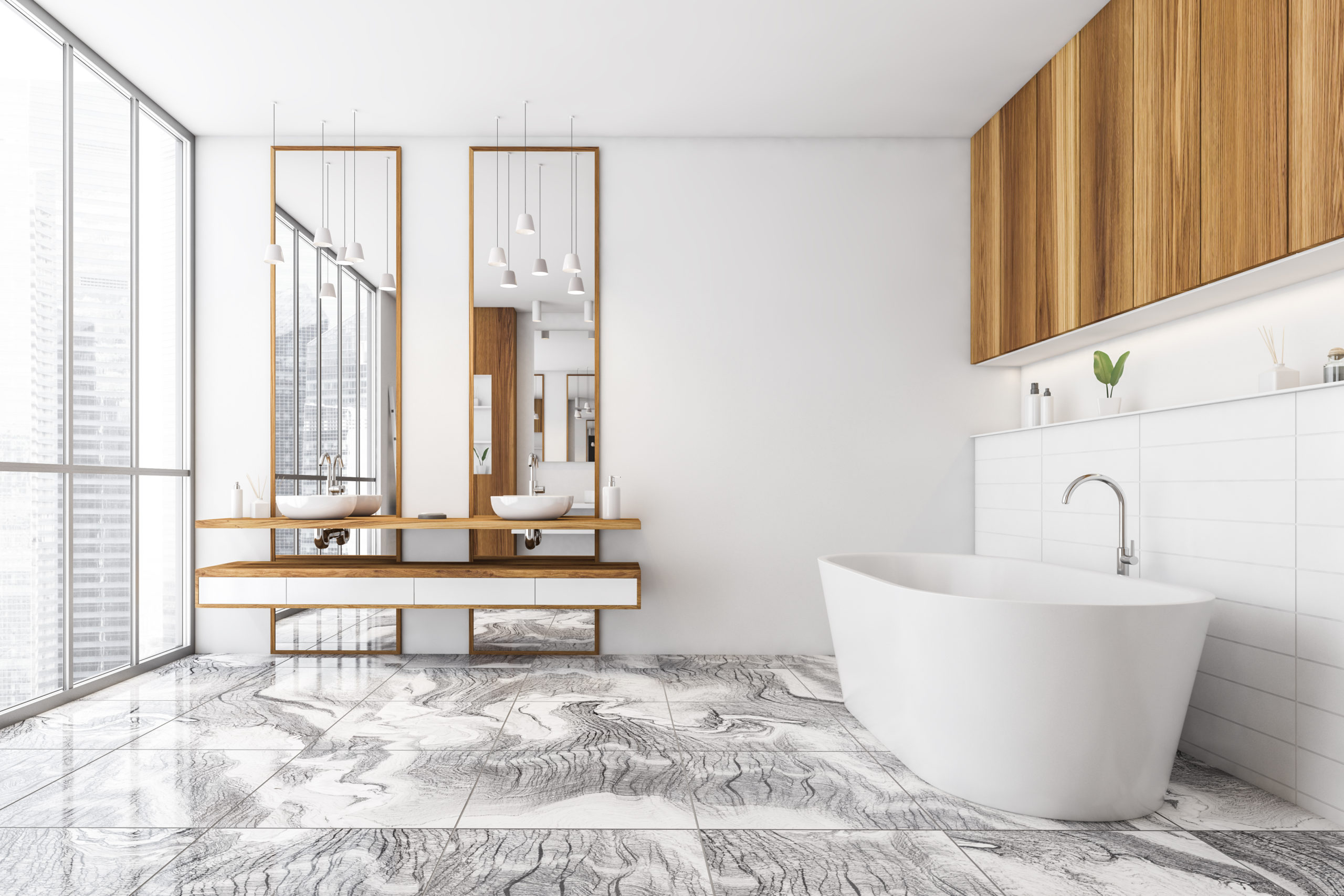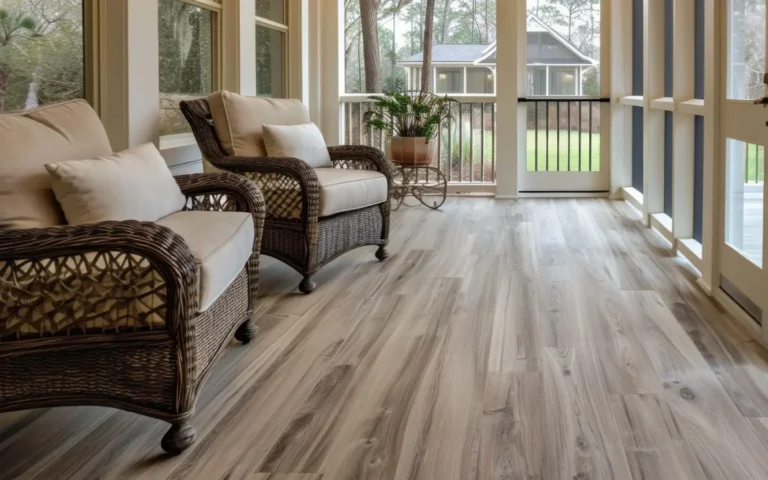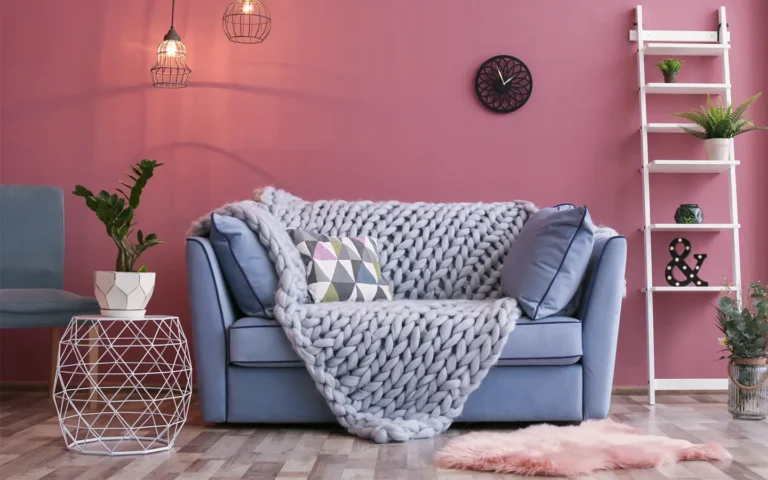This post may contain references or links to products from one or more partners of our parent company and/or subsidiaries of our parent company. For more information, visit this page.
March 9, 2022
Looking for the best flooring for your bathroom, but not sure where to start? We totally understand. Bathrooms are a unique area in your home—they don’t typically get a lot of foot traffic, but they do see a lot more water than most other rooms.
So, how do you even begin deciding on the best bathroom flooring? We’re so glad you asked!
Below, we’ll go over some of the essential factors you should look for when choosing your new bathroom floor. Then, we’ll talk about our 7 favorite bathroom flooring ideas, plus each one’s pros and cons. Finally, we’ll go over a few types of flooring that you should never install in your bathroom!
Ready to talk about the best flooring for bathrooms? Let’s jump in!
How to Choose the Best Bathroom Flooring for Your Home
You have a ton of great options for your bathroom flooring. However, choosing the best bathroom flooring will be based on your particular needs.
Think about your unique circumstances to help you sort through all the different flooring ideas. For example, is this floor going in a children’s bathroom that will see tons of water splashed on the floor? Is the person using the bathroom prone to slipping?
By focusing on what you need out of your bathroom floor, you’ll be able to zero in on what type of bathroom flooring most suits your needs.
Durability is Important
How much traffic does this bathroom typically see? If it’s the main bathroom that the entire family uses daily, you want something like SPC flooring that can take a beating. On the other hand, a guest bathroom that is rarely used might be a good opportunity to cut costs with peel and stick vinyl plank flooring, or even experiment with different wood floor designs.
The point is this: the busier your bathroom is, the more durable your bathroom flooring should be.
Choose the Right Installation Method
As always, we recommend spending a little bit extra to have a professional take care of the installation for you. But if you’re determined to make the project you’re looking to save some money, keep an eye out for DIY-friendly flooring (like DIY wood flooring, or click-together options like Shaw laminate flooring).
Easy Maintenance Will Make Life Simpler
“Cleaning my bathroom floor is my favorite pastime,” said nobody ever. We all want to do as little cleaning as possible, so choose a floor that’s easy to maintain (or repair, if necessary).
The best vinyl plank flooring brands are no-brainers on this front—brands like Doma and Karndean vinyl plank flooring specialize in products that’re stylish and great at handling spills.
And speaking of spills…
The Best Bathroom Flooring Must Be Waterproof or Water-Resistant
The best bathroom flooring is going to be similar to the best flooring for dogs or mudroom flooring—it’s going to need to handle getting wet. Sadly, that eliminates some of the otherwise best hardwood flooring brands, and makes niche options like hemp flooring or magnetic flooring impossible.
When you’re shopping for your bathroom floor, you also need to consider how much water is likely to wind up on your floor. This could mean the difference between needing waterproof bathroom flooring and water-resistant bathroom flooring.
What’s the difference between the two? Waterproof flooring is just what it sounds like—completely impervious to water. Water-resistant flooring can still handle spills, but large amounts of water can cause long-term damage.
Best Brands of 2024
The Best Bathroom Flooring: 7 Great Options
Now that we’ve established everything you need to keep in mind when you’re selecting your bathroom flooring, let’s get into the 7 best bathroom flooring options!
#1. Luxury Vinyl Plank/Tile (LVP/LVT)
LVP isn’t just the best flooring for kitchens—it’s some of the best flooring for bathrooms, too! But this isn’t your grandma’s vinyl flooring—it’s come a long way from the original, cheap-looking versions from back in the day.
What is Luxury Vinyl?
Luxury vinyl is a form of PVC flooring that’s (generally) composed of 3 layers:
- A core layer (or base layer) that provides structure and rigidity.
- A design layer that is designed to mimic wood or tile.
- A transparent wear layer that protects the plank from damage.
And as a disclaimer, luxury vinyl plank is the exact same thing as luxury vinyl tile—you’ll see them used pretty much interchangeably.
Vinyl Sheet Flooring Can Be a Great Option, Too
The best vinyl flooring for bathrooms (or any room, really) is going to be vinyl plank. But there’s another option—vinyl sheet!
Remember when we said, “this isn’t your grandma’s vinyl flooring”? Well, vinyl sheet basically is your grandma’s vinyl—it’s one single sheet of vinyl that’s laid over your subfloor. It’s not as nice to look at (or as durable), but sheet vinyl does have some advantages! Since it’s a single sheet, there are no gaps for water to leak through when spills inevitably occur.
Look, we’d almost never recommend sheet vinyl over LVP, but it’s an option to consider when you’re looking for the best bathroom flooring!
Why Luxury Vinyl is Some of the Best Flooring for Bathrooms
Alright, now that we’ve gone into what exactly luxury vinyl is (and its differences from traditional sheet vinyl, let’s look at why it’s one of the best bathroom flooring options.
All Vinyl Flooring is Waterproof
Yep, you read that right—waterproof vinyl flooring is just regular old vinyl flooring! It’s what makes vinyl some of the best flooring for basements, and a rock-solid choice for bathrooms.
Vinyl Plank is Some of the Easiest Flooring to Install (and Maintain)
Whether you install glue-down, snap-together, or floating vinyl plank flooring, vinyl is some of the easiest flooring to install. And even if you choose to hire a professional installer (which we always recommend), the cost to install vinyl plank flooring is pretty low.
And when it comes to keeping your bathroom clean and germ-free, LVP flooring is incredibly simple to maintain.
Why Luxury Vinyl Might Not Be the Best Flooring for Bathrooms
Of course, LVP isn’t perfect—nothing in life is (except maybe Jeff Goldblum). It’s still a top bathroom flooring choice, but there are a few things to consider when it comes to luxury vinyl in the bathroom.
Some Vinyl Flooring Can Emit VOCs
Of course, no product is perfect—there are some disadvantages of vinyl plank flooring, too. Since vinyl is made of plastic, it can often emit high levels of volatile organic compounds (VOCs). VOCs are the chemicals that give off that “new car smell”, and they’re emitted by pretty much every industrial product.
That said, VOCs in small amounts won’t negatively affect your health. Make sure you install certified low-VOC vinyl flooring (and low-VOC flooring in general, since VOCs can be found in almost every type of flooring).
While It’s Easy to Maintain, Luxury Vinyl is Tough to Repair
Vinyl isn’t like hardwood—you can’t just refinish it when it gets scratched. With vinyl plank, repairing a damaged floor takes a lot of work, special products, and a bit of luck.
More often than not, you’re probably going to end up throwing damaged vinyl out, which isn’t an easy task (nor an environmentally friendly one).
#2. Tile (Ceramic and Porcelain)
Now onto a crowd favorite: tile! Tile is very likely the first thing that comes to mind when you think of the best bathroom flooring, and it’s some of the best flooring for the job.
Ceramic vs. Porcelain Tile
Although they’re largely similar, there are slight differences that distinguish these two types of tile. Specifically, the distinction is defined by the temperature at which the tiles are baked and how much water they absorb.
Both actually start as ceramic tile, which is natural clay heated at a very high temperature to make it incredibly hard. But porcelain is baked at a higher temperature, making it more durable and less porous (which means less water seeping in). That’s makes porcelain tile a slightly better bathroom flooring option, but ceramic is still pretty darn tough!
Why Tile is Some of the Best Flooring for Bathrooms
If you close your eyes and try to imagine a bathroom, there’s a good chance that it’s going to have tile flooring. And that’s because it’s some of the best flooring for bathrooms—let’s look at why.
Tile Comes in a Variety of Styles
Ceramic and porcelain tile can come in a wide variety of shapes, sizes, colors, and designs, which really opens up the floor (pun intended) for your design skills to shine. Will you go with a classic white square look, or use something unique like wood-look tile as a fake wood flooring option? The choice is yours!
Tile Flooring Can Be Waterproof
There’s a slight caveat to this. Tile flooring is completely waterproof, provided that:
- It’s from a quality brand that doesn’t cut corners.
- It’s installed correctly.
If there are mistakes in the grouting, water can seep into your subflooring and cause some real damage. All the more reason to work with a local flooring expert!
Plus, Tile is Kid-Friendly
Tile is great for families with kids. Its water resistance, combined with the fact that it’s super durable and easy to clean, makes this some of the most kid-friendly flooring out there. Your child can splash to their heart’s content!
Why Tile Might Not Be the Best Flooring for Bathrooms
Tile might be the default flooring for bathrooms, but that doesn’t mean it’s without flaws. Now let’s break down why it might be a good idea to go a different direction with your bathroom flooring.
Installing Tile is Tricky
If you’re in the market for do-it-yourself flooring, you’ll probably want to look elsewhere. Working with tile requires a lot of expertise, and installation mistakes can be costly. And if you’re thinking of installing snap-together tile flooring in your bathroom… well, let’s just say we wouldn’t necessarily recommend it.
Tile Can Get Really Slippery
Perhaps the biggest knock against tile is how slippery it is, especially if it gets wet (and since we’re talking about bathroom flooring, that’s going to happen pretty frequently). For older adults who might be less steady on their feet, tile might not be the best choice.
#3. Hardwood
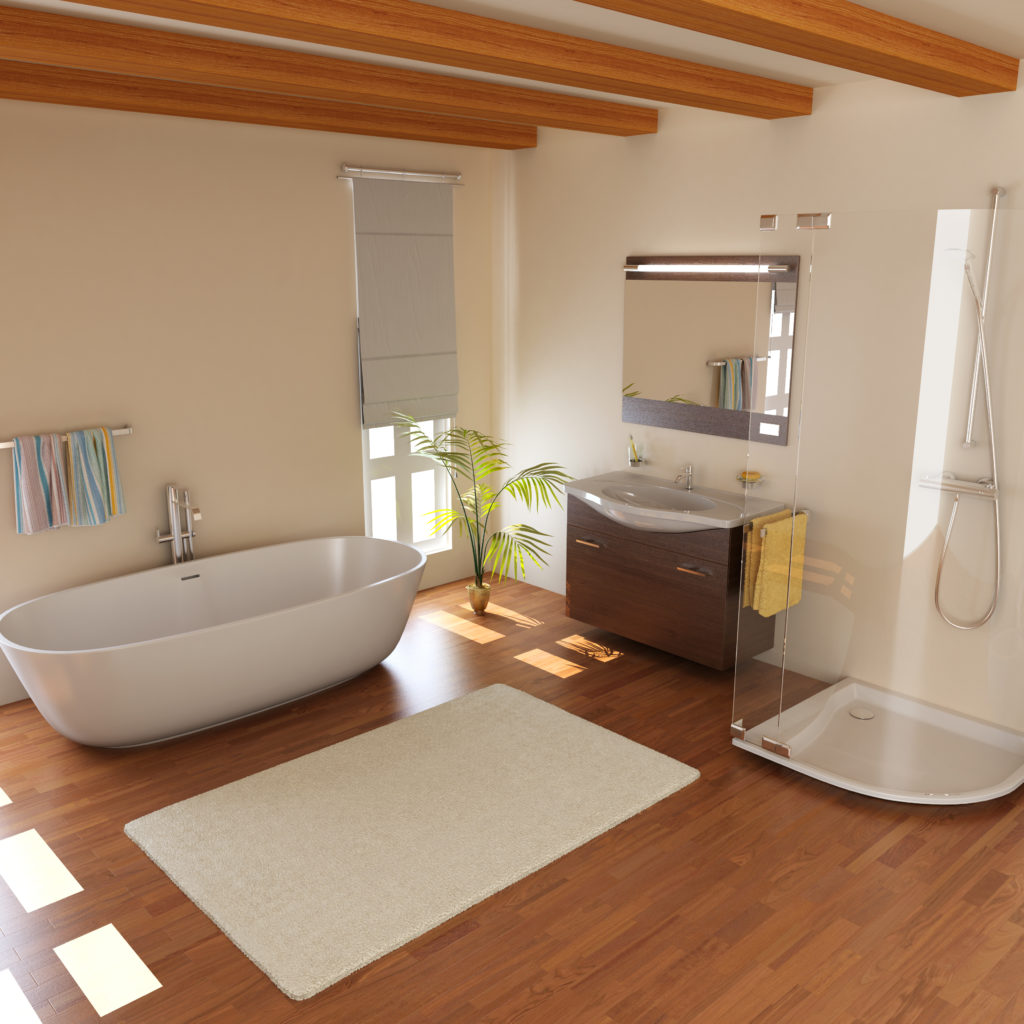
You might have thought a genuine wood floor bathroom was a pipe dream, like world peace or a real-life Jurassic Park. But hardwood is versatile—it isn’t just some of the best bedroom flooring, it’s some of the best flooring for bathrooms, too!
Solid vs. Engineered Hardwood: What’s the Difference?
First, let’s look at the two main wood flooring types: solid and engineered hardwood. Solid wood flooring is pretty straightforward—it’s a plank of wood that’s the same throughout.
So then, what is engineered hardwood? Engineered hardwood is genuine wood all the way through, despite what the name might suggest. Specifically, it’s composed of a thin hardwood veneer, layered on top of a high-performance base layer made of plywood or HDF.
Not all engineered wood is waterproof, and even some of the most durable flooring shouldn’t be installed in bathrooms. But some brands (like Proximity Mills) offer high-quality waterproof wood flooring—a must-have in any wood floor bathroom.
Why Hardwood is Some of the Best Flooring for Bathrooms
Because waterproof hardwood flooring is constantly getting better, it’s already becoming a more viable bathroom flooring option.
Hardwood is Naturally Beautiful
This one is obvious—who doesn’t love a hardwood floor? With a wide range of wood floor colors and designs, hardwood can add beauty to any space—including a bathroom!
Engineered Wood Won’t Warp as Easily
A major benefit of engineered wood: due to its engineered core, it’s more dimensionally stable than its solid wood counterpart. This prevents any shrinkage or swelling that occasionally happens with solid hardwood, and means you can install engineered wood where solid wood can’t (or at least, shouldn’t) go.
Why Hardwood Might Not Be the Best Flooring for Bathrooms
Of course, there are reasons why hardwood isn’t as popular as some of the other best hardwood flooring options. There are some things you might want to consider before you commit to the wood floor bathroom.
Engineered Wood Can’t Be Refinished Often
One of the disadvantages of engineered wood: it can’t be refinished as often as solid wood because of the thin wood veneer.
But here’s the thing: the best engineered wood flooring is so well-made these days, it doesn’t even need to be refinished more than once or twice (if ever). Which means you don’t have to worry about the cost to refinish hardwood flooring.
Hardwood Isn’t Completely Impervious to Water
Keep in mind: wood floors are still pretty susceptible to damage from standing water. That makes them best suited for bathrooms that don’t get much water use, like a half-bath or guest bathroom.
If you’re going with a hardwood bathroom, make sure you install either water-resistant wood flooring or fully waterproof hardwood floors. Additionally, we recommend installing prefinished hardwood flooring rather than finishing it yourself—factory finishes are more likely to keep the wood completely sealed.
#4. Natural Stone Tile
We aren’t done discussing tile just yet! Ceramic and porcelain aren’t the only types of floor tiles on the market—you can’t forget about natural stone tile!
What is Natural Stone Tile?
Natural stone tile is any tile made from granite, marble, limestone, travertine, etc. (you know, stones!). Because it’s carved from real stone and not fired from clay like ceramic or porcelain, natural stone tile can cost a very pretty penny.
Why Stone Tile is Some of the Best Flooring for Bathrooms
Stone tile is gorgeous, and gives your bathroom (or any space) an added touch of elegance. Here’s why it might just be the best bathroom flooring available.
Natural Stone Tile Impresses Potential Home Buyers
Where natural stone tile gets an extra point when you’re comparing tile vs. laminate (and even tile vs. wood flooring): resale value! Natural stone is considered so luxurious that it will boost your home’s long-term resale value. It’s not the only reason to go with a natural stone tile bathroom, but it sure doesn’t hurt!
One of the Strongest Floors Available
Natural stone is also incredibly durable, as you might expect. Natural stone tile floors, when properly cared for, can last a lifetime. And when you’re looking for the best bathroom flooring options, it’s reassuring to know that you won’t need to be redoing your floor again for a very long time.
Why Stone Tile Might Not be the Best Flooring for Bathrooms
Here’s the thing—there’s a reason stone tile isn’t as common as ceramic or porcelain tile. It’s a gorgeous bathroom flooring option, but stone tile doesn’t come without its own drawbacks.
Natural Stone Tile Is A Significant Investment
You probably won’t be shocked to learn: as a luxury item, stone tile also happens to be quite costly. Natural stone tile is probably the most expensive flooring out there.
But it isn’t material costs alone—stone tile installation is far from easy, so you will absolutely need to pay a professional to come to install it for you.
Natural Stone Requires Frequent Maintenance
It’s also a high-maintenance flooring. Although it’s a very strong material, unlikely to break, it is also fragile in the sense that it is susceptible to scratches and stains. Therefore, you will need to reseal it every few years. This will help protect the surface and also maintain its waterproof nature.
#5. Waterproof Laminate Flooring
Laminate is one of your best bathroom flooring choices, as long as it’s waterproof and properly installed. The best laminate flooring brands don’t stand a chance as bathroom flooring if the flooring isn’t waterproof, and even a lot of waterproof laminate isn’t ideal for bathrooms.
Regardless, it’s reliable enough that we still consider it one of the best bathroom flooring options!
What is Laminate Flooring?
You may still be asking yourself what is laminate flooring? Totally understandable.
Laminate flooring is composed of a composite wood base, with a realistic image of wood grain or stone, and is finished with a clear protective wear layer.
You might be thinking, “hey, that sounds a lot like engineered wood flooring!” But the major difference between hardwood vs. laminate flooring is what’s between the core and wear layers—because laminate uses an image layer rather than real wood, it can’t be refinished and is much less durable than engineered wood.
Not All Laminate Flooring Is Waterproof
Some types of laminate flooring aren’t waterproof, so be sure to do your research if you decide to go with laminate flooring in your bathroom. Brands like RevWood and AquaGuard flooring are specially designed to be waterproof laminate flooring—and some like Newton also carry waterproof options.
A good rule of thumb here is this: bigger brands will usually carry some type of waterproof laminate. There’s a waterproof Shaw laminate flooring line, a waterproof Mohawk laminate flooring line, you get the picture. But again: waterproof is key if your ideal bathroom flooring is a laminate product.
#6. Stained Concrete
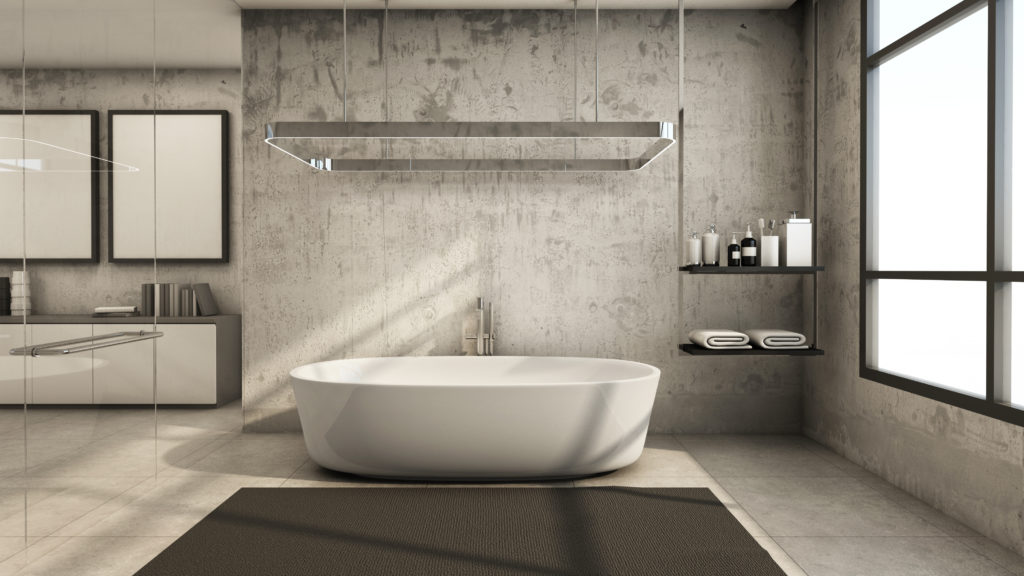
Concrete in a bathroom? What is this, a gas station?
Hear us out! Stained concrete is so much more than you might imagine—for instance, did you know that you can have concrete flooring that looks like wood? How cool is that?
Let’s get to why stained concrete is some of the best flooring for bathrooms.
What is Stained Concrete?
Stained concrete flooring is almost exactly what it sounds like: a solid slab of poured concrete. But with stained concrete, a colored stain has been added to the surface layer, which makes the surface difficult to crack or chip.
Stained Concrete Is Durable and Affordable
Concrete is some of the toughest, longest-lasting flooring you can have—even the most durable wood flooring doesn’t hold a candle to its durability! On top of that, it’s not nearly as expensive as other types of flooring. That means you’ll save money in the short-term on installation, and in the long term due to its durability. It practically pays for itself!
Concrete Requires Sealing to Protect from Water
This might surprise you: concrete isn’t actually totally waterproof. At least, not on its own.
Concrete needs to be sealed to keep out water, which is something you’ll absolutely need if you’re looking to install concrete in your bathroom.
Concrete isn’t the Most Comfortable Flooring
Similar to tile, concrete can often be cold and slippery when wet. You can reduce the slipperiness of your concrete floor by adding some texture upon installation, but there’s not much you can do about the cold. Concrete flooring isn’t a candidate for radiant heating that you see in heated wood flooring—if the cold really bothers you, the best you can do is install a few bathmats.
It Could Negatively Affect Your Resale Value
Future buyers may not understand that concrete can often be the best bathroom flooring, so they may be turned off if they see a concrete bathroom. But it’s becoming increasingly with modern home design, so this might not be the case for long!
#7. Engineered Bamboo Flooring
There’s a lot to love about engineered bamboo! Of course, this comes with the caveat that the best bamboo flooring for your bathroom needs to be (drumroll, please…) waterproof.
What is Engineered Bamboo Flooring?
Bamboo flooring isn’t wood at all! It looks remarkably like hardwood, but bamboo is actually grass.
Engineered bamboo (which is what you’ll want to use for your bathroom) is constructed the same way as engineered wood: a solid bamboo veneer layer, supported by plywood or HDF core. That means most (if not all) engineered wood disadvantages we broke down earlier apply to bamboo as well.
Engineered Bamboo is Extremely Durable
Engineered bamboo flooring is among the best flooring for bathrooms because it is durable as all get-out. Should it take some damage, you can refinish your bamboo flooring—but just like engineered wood, don’t expect to be able to refinish more than once or twice.
And also just like engineered wood, make sure any engineered bamboo flooring you install in the bathroom is waterproof (or at least water-resistant).
Plus, Bamboo Flooring is Ultra Sustainable
Looking for a sustainable wood flooring option? Then bamboo should be at the top of your list. When you compare the sustainability of something like bamboo flooring vs. laminate (or really most other flooring types), it’s basically a no-contest. Bamboo is just that sustainable.
High-Quality Bamboo Flooring is Expensive (But Worth It)
One of the big negatives in the list of engineered bamboo flooring pros and cons—the cheap stuff is really cheap. Quality falls off pretty drastically for cheaper, poorly made engineered bamboo.
In short: if you’re going to install engineered bamboo, it’s worth investing a little extra for high-quality flooring. It will save you in the long run!
The Worst Bathroom Flooring Options
Some flooring should just never be used in a bathroom. Not all flooring is friendly to water, so it should stay far away from bathrooms. Let’s look at 3 of the worst bathroom flooring options.
Carpet
Yeah, we really love carpet; we even like to layer a rug on carpet! But in the bathroom? That’s a hard no. Cut pile carpet, loop pile carpet,, nylon, polyester, it doesn’t matter—not even the best carpet brands are suitable for a bathroom.
Water is really bad for all types of carpet. It doesn’t matter if you aren’t dumping water on the floor, either, because it is in the air of your bathroom. All that moisture and steam will cause mold and mildew in your carpet fibers, which can cause health problems (and ruin your subfloor).
Put it this way: carpet vs. hardwood might be a silly debate in general. But in a bathroom? Well, that’s a silly debate for a different reason. Stay away!
Non-Waterproof Laminates
Waterproof laminate is some of the best flooring for bathrooms. But non-waterproof laminate? Well, it’s tough to find a worse option.
Unfortunately, not all laminate flooring is waterproof. Even the best laminate flooring is useless in your bathroom if it isn’t waterproof. Water will seep between the planks, causing them to swell and warp.
If you’re determined to go with laminate, do your research and make sure it’s waterproof.
Cork Flooring
Look, we love cork flooring, and it probably doesn’t get enough love. But it does not belong as a bathroom floor. There are a lot of disadvantages of cork flooring, but the real killer here is water (AKA, that stuff that’s everywhere in a bathroom). Changes in humidity can cause real warping, and even the best cork flooring will absorb moisture rather than repel it.
Conclusion
As you can see, there is a lot to consider when choosing the best bathroom flooring. It needs to be able to withstand water, be simple to clean, and (of course) look great. We hope this article helped narrow down your choices, or maybe even gave you some ideas you hadn’t considered!
Ready to get started? Reach out to a flooring store near you and let them help you zero in on the best flooring for your bathroom.
Good luck on your floor buying journey!
- Shaw Vinyl Plank Flooring Reviews 2022
- Vinyl Plank Flooring on Stairs: Your Total Guide
- Wide Plank Wood Flooring 101: The Total Guide
- The 2022 Hardwood Floor Buying Guide
- 15 Beautiful and Affordable Outdoor Flooring Options
- The 10 Best Types of Wood Flooring For Dogs
- SmartCore Flooring Reviews: Is it Worth it?
- Costco Laminate Flooring Reviews 2022
About The Author

Courtney Daily
March 9, 2022
Courtney is a freelance writer who wears many other hats: kindergarten teacher by day, Broadway diva in the shower. She is a transplant Hoosier who originated in New England. When she isn't writing in her spare time, you will find her reading history books, arguing with her latest knitting project, or being beaten by her kids at most games.
